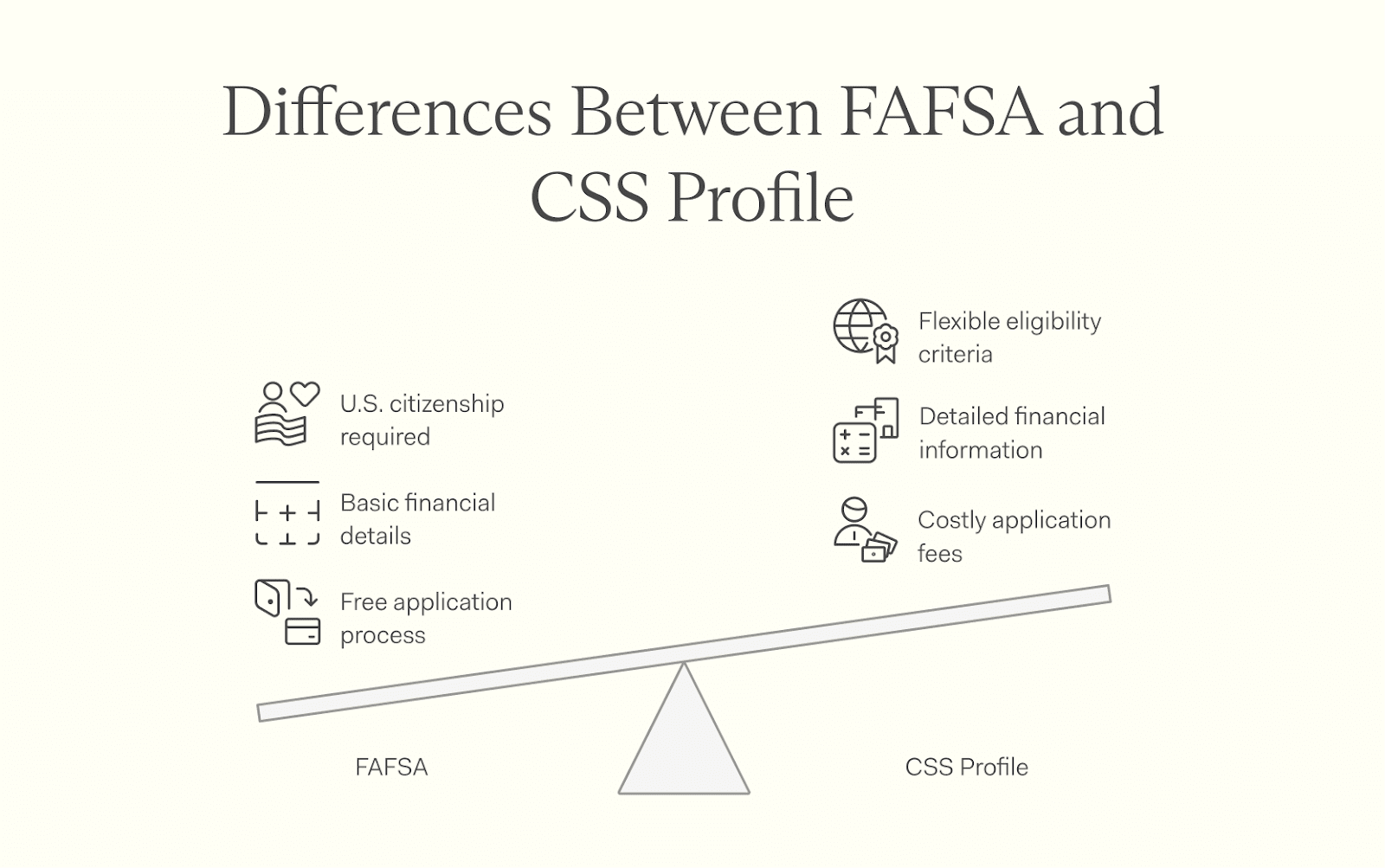Confused about financial aid options? Discover the differences between the CSS Profile and FAFSA to make an informed choice.
College costs continue to climb, making financial aid not just helpful but necessary for most students. Yet many families find themselves confused by the application process and unsure where to begin.
The FAFSA and CSS Profile are two key tools in the financial aid process. The FAFSA helps you access federal student aid, while the CSS Profile is used by private colleges for institutional aid.
Both forms collect your financial information but in different ways.
This guide breaks down what makes these forms different, what each can offer you, important deadlines to know, and whether you should complete one or both in your quest for college funding.
FAFSA stands for the Free Application for Federal Student Aid. It helps students apply for federal loans, grants, and work-study programs to pay for college.
This application determines eligibility for grants, loans, and work-study programs based on financial need. It serves as the gateway to federal financial aid.
The application is free and used nationwide by colleges to award aid. As the U.S. Department of Education states:
Completing the FAFSA is your first step toward getting money for college.
Submitting the FAFSA connects you to federal, state, and school-based funding sources for your education.
The CSS Profile is an online form for financial aid. It helps colleges and scholarship programs decide how much aid you may receive.
Unlike the FAFSA, the CSS Profile examines your family's finances in greater detail. It looks deeper into your financial situation to help colleges make aid decisions.
Many private colleges require the CSS Profile to award institutional aid, like grants or scholarships they fund themselves. It digs deeper into income, assets, and expenses to determine aid eligibility. Unlike the FAFSA, it considers medical bills, school costs for siblings, and other unique factors.
This application helps colleges determine financial aid from non-federal sources. It focuses on institutional aid based on your family's unique financial situation.
FAFSA and CSS Profile serve different purposes in financial aid. They collect unique information and follow separate procedures—each has specific rules to understand.

The FAFSA collects basic financial details like your income, assets, and family size. It uses this to calculate your Student Aid Index (SAI), which helps decide federal aid eligibility.
Schools can also use it for state or institutional aid.
The CSS Profile digs deeper into finances. It asks about home equity, medical expenses, and even non-custodial parent contributions. This form helps colleges determine need for scholarships or specific school aid programs.
FAFSA is free for all students. You don't pay anything to fill out or submit it.
The CSS Profile, on the other hand, costs $25 for one school and $16 for each additional college you're considering. Fee waivers are available for eligible students with financial need.
Schools registered by the College Board may require this application to determine your eligibility for institutional aid.
Filling out the FAFSA requires U.S. citizenship or eligible non-citizen status. Students must have a valid Social Security number and a high school diploma or equivalent. Male students aged 18-25 need to register for Selective Service.
The CSS Profile has no strict citizenship requirements but depends on individual school policies. Some schools may ask international students to complete the CSS Profile application for financial aid.
Both require accurate income and tax information from students and their families—keep these documents handy before you submit your form.
Keeping track of submission dates is crucial for maximizing your financial aid opportunities. Missing these deadlines can significantly impact your award eligibility.
Applying for both the FAFSA and CSS Profile can increase your chances of receiving more financial aid. The FAFSA is free, while the CSS Profile costs money but considers more factors, like home value and medical expenses.
Some schools require both forms to assess financial need fully. Completing them helps access federal, state, and institutional aid. Check each school's requirements to avoid missing out on funds.
Both the FAFSA and CSS Profile open critical pathways to college funding. While the FAFSA provides free access to federal and state assistance, the CSS Profile offers a more comprehensive financial review at a modest cost.
Submitting both forms when required can significantly boost your potential aid package. Remember that deadlines are firm—apply on time or risk losing thousands in potential support. Take charge of your educational future by completing the appropriate forms for your college list and submitting them well before deadlines.
FAFSA is used to determine federal and state aid, while the CSS Profile—administered by the College Board—helps colleges and scholarship programs decide on institutional aid.
No, not all schools require both. Some only need FAFSA, but many private schools use the CSS Profile for additional financial details.
You complete it online at the federal student aid website each year to apply for financial aid like grants, loans, or work-study programs.
Yes, since the CSS Profile takes into consideration more detailed financial information compared to FAFSA's simpler format.
FAFSA provides access to federal and state aid based on expected family contribution (EFC). The CSS Profile usually helps with institutional scholarships or grants offered directly by colleges.
Yes! Students may still fill out their own applications if required by certain scholarships or programs that don't depend solely on need-based criteria.